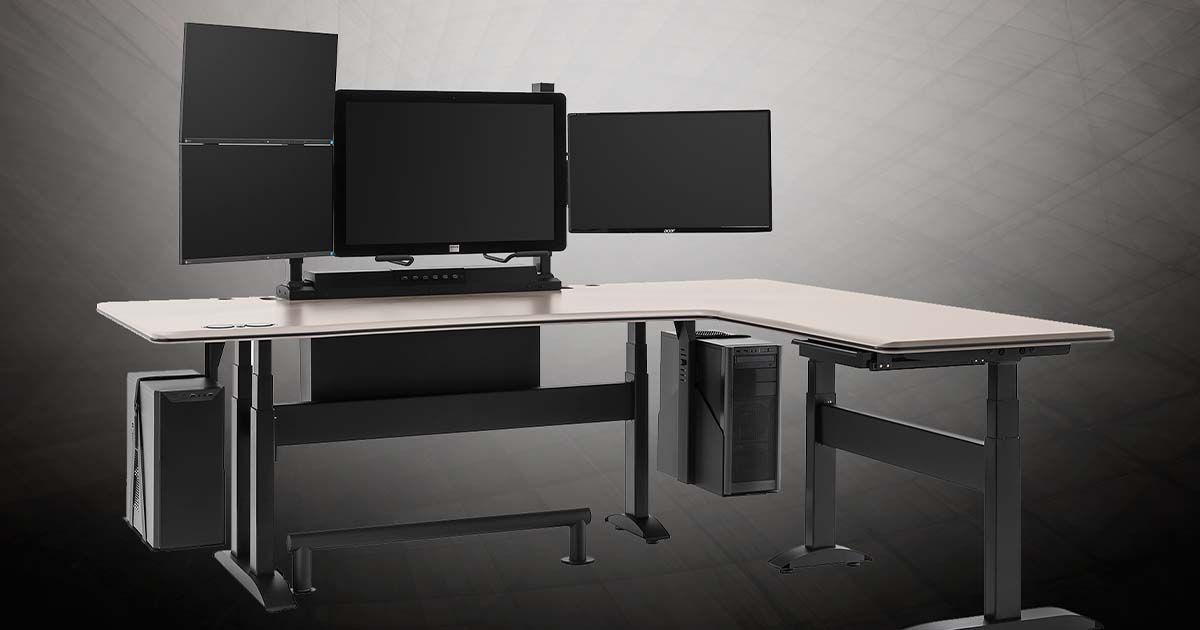
We collect basic website visitor information on this website and store it in cookies. We also utilize Google Analytics to track page view information to assist us in improving our website.

Radiologists are no strangers to the challenges posed by long hours of sitting. It's a stark reality in today’s healthcare landscape, and it's sparking a growing conversation about the need for ergonomic solutions.
In this blog post, we'll explore how the sedentary nature of radiology affects radiologists’ health, and the rise of sit-to-stand desks as a potential remedy.
At RedRick Technologies, we design and develop ergonomic workspaces for healthcare professionals that include workstations, monitor mounting solutions, accessories, and peripherals. We also provide ergonomic design services that help organizations implement ergonomic principles for improved space design and functionality. Get in touch and let’s find ways to improve the ergonomic functionality of your workspace.
Radiologists face the challenge of prolonged periods of sedentary work, which, despite its necessity, carries significant health risks.
The impact of a sedentary lifestyle is far-reaching, affecting various aspects of physical and mental health, including:
Extended sitting can lead to the weakening and atrophy of large leg and gluteal muscles, crucial for walking and stability. This muscular degradation heightens the risk of injuries, including falls and strains during physical activity.
Living a sedentary lifestyle impairs the body’s ability to efficiently digest fats and sugars, leading to their accumulation as body fat. This is true even for those who engage in exercise but spend substantial time sitting.
The hips and back suffer from prolonged sitting. The shortening of hip flexor muscles can lead to hip joint issues, while the spine may experience compression and premature degeneration, especially with poor posture or inadequate ergonomic support. This can result in significant pain and reduced mobility.
Heart disease and diabetes are notably linked to extensive sitting. Studies reveal a stark increase in the risk of heart disease and stroke for individuals who sit for extended periods. Similarly, the risk of diabetes skyrockets due to increased insulin resistance caused by inactivity.
The links between prolonged sitting and mental health issues like anxiety and depression are becoming clearer. Lack of physical activity can deprive individuals of the mental health benefits of exercise.
Emerging research suggests a connection between extended sitting and the risk of certain cancers, including lung, uterine, and colon cancers.
In response to these concerns, national and international health guidelines, including those from the World Health Organization, now advocate for reducing or breaking up sedentary time.
This is where the role of ergonomic workstations, such as standing or sit-to-stand desks, contributes to the solution.
Standing desks and sit-to-stand desks are two types of workstations designed to reduce the amount of time spent sitting.

Research on the health benefits of sit-to-stand desks, especially as a tool to counteract sedentary work habits, is still in its infancy. With the rise in mainstream interest over recent years, more resources are being allocated to study their effectiveness.
To date, there is minimal evidence to confirm that standing more at work fully negates the negative effects of a sedentary lifestyle. However, the health risks associated with prolonged sitting, such as obesity, cardiovascular disease, and increased overall mortality, are well-established.
Contrasting with the limited clinical evidence, subjective reports from sit-to-stand desk users paint a more positive picture. A study published in the British Medical Journal highlighted that interventions like height-adjustable desks led to improvements in well-being, stress, vigor, and lower extremity pain. Users also reported feeling more energized, focused, and productive when incorporating standing into their workday.
The clear risks posed by sedentary lifestyles underscore the importance of breaking up sitting time with frequent movement — which is exactly what a sit-to-stand workstation setup offers.
Experts say that simple activities like standing during phone calls, using a standing desk, or taking short walks every hour can help maintain muscle tone, improve blood circulation, and enhance overall mental and physical well-being, helping to counteract the negative effects of sitting.
While more research is specifically needed on the impact of sit-to-stand or standing desks on radiologists, the general trend suggests that these ergonomic solutions offer a way for radiologists to integrate more movement into their day. This is a benefit that can extend to all workers who spend significant portions of their day sitting.
While the scientific community has yet to reach a consensus on the definitive health benefits of sit-to-stand and standing desks, the anecdotal benefits and the well-documented risks of a sedentary lifestyle highlight the potential of these ergonomic solutions.
For radiologists and similar professionals, incorporating elements that encourage movement, like sit-to-stand desks, could be a significant step towards mitigating the health risks associated with prolonged sitting.
At RedRick Technologies, we recognize the unique demands of healthcare professionals, particularly radiologists, who spend extensive periods in a sedentary position. Our commitment to addressing these challenges is evident in our range of ergonomic workspaces, designed to improve comfort, functionality, and overall health.
A key feature of our workstations is their height adjustability. Every RedRick workstation is designed to accommodate a range of heights, from 24 to 49.5 inches, or from 22-48 inches above the floor.
This flexibility not only meets but exceeds the ANSI BIFMA standards (22-48 inches), ensuring that every user can find their optimal working height.
Understanding the varied and often heavy equipment used in radiology, our sit-to-stand workstations are engineered to lift heavy loads without compromising stability or functionality.
Our expertise extends beyond workstations. At RedRick Technologies, we offer a complete suite of solutions, including monitor mounting options, a variety of accessories, and peripherals, all tailored to enhance ergonomic efficiency.
Each product is designed with the specific needs of healthcare professionals in mind, ensuring that every aspect of their workspace supports their health and productivity.
And since each workspace has its unique challenges and requirements, we provide specialized ergonomic design services. Our team works closely with clients to understand their specific needs and to devise solutions that best address those needs.
We invite healthcare professionals and organizations to get in touch with us to explore how we can enhance the ergonomic functionality of their workspaces. Whether it's customizing workstation configurations or developing comprehensive ergonomic strategies, our goal is to create work environments that are not only efficient and comfortable but also conducive to the well-being of healthcare professionals.
Height adjustable desktop (standard/critical feature)
Our recommended/standard range of adjustment is 24-49.5” above the floor
ANSI BIFMA standard of 22-48” is also available
The size and shape of the desktop are limitless and determined by physical space available, computer hardware to be hosted, and user preference.
Height adjustment (standard/critical feature)
Motorized height adjustment providing 12” of vertical range
All monitors adjust simultaneously
Virtually any monitor configuration can be accommodated
Focal distance adjustment (standard/critical feature)
Effortless manual adjustment, found to be the most intuitive and easy-to-engage method, providing 16” of horizontal forward/back range as well as 60 degrees of side-to-side swivel
Virtually any monitor configuration can be accommodated
Our monitor mounts can handle the heaviest monitor setups. These monitor mounts are designed to accommodate large, high-resolution displays and multiple screens for demanding tasks.
Unlike traditional “split-level” or “keyboard tray” models, RedRick’s mounts allow for single-work-surface solutions that retain maximum usable space, while providing superior, intuitive, and easy ergonomic adjustment.
At RedRick Technologies, we design and develop ergonomic workspaces for healthcare professionals that include workstations, monitor mounting solutions, accessories, and peripherals. We also provide ergonomic design services that help organizations implement ergonomic principles for improved space design and functionality.
Get in touch and let’s find ways to improve the ergonomic functionality of your workspace.